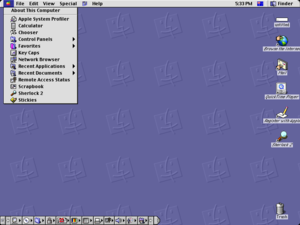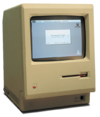Our website is made possible by displaying online advertisements to our visitors.
Please consider supporting us by disabling your ad blocker.
Classic Mac OS
 | |
 Screenshot of Mac OS 9 | |
| Developer | Apple Computer |
|---|---|
| OS family | Macintosh |
| Working state | Historic, not supported |
| Source model | Closed source |
| Initial release | January 24, 1984[1][2] |
| Final release | 9.2.2 / December 5, 2001[3] |
| Marketing target | Personal computing |
| Platforms | |
| Kernel type | Monolithic for 68k, nanokernel for PowerPC |
| Default user interface | Graphical |
| License | Commercial software, proprietary software |
| Succeeded by | Mac OS X |
| Support status | |
| Historical, unsupported as of February 1, 2002 | |
| Part of a series on |
| Classic Mac OS |
|---|
 |
| Part of a series on |
| macOS |
|---|
Mac OS (originally System Software; retronym: Classic Mac OS[a]) is the series of operating systems developed for the Macintosh family of personal computers by Apple Computer, Inc. from 1984 to 2001, starting with System 1 and ending with Mac OS 9. The Macintosh operating system is credited with having popularized the graphical user interface concept.[4] It was included with every Macintosh that was sold during the era in which it was developed, and many updates to the system software were done in conjunction with the introduction of new Macintosh systems.
Apple released the original Macintosh on January 24, 1984. The first version of the system software, which had no official name, was partially based on the Lisa OS, which Apple previously released for the Lisa computer in 1983. As part of an agreement allowing Xerox to buy shares in Apple at a favorable price, it also used concepts from the Xerox PARC Alto computer, which former Apple CEO Steve Jobs and other Lisa team members had previewed.[1] This operating system consisted of the Macintosh Toolbox ROM and the "System Folder", a set of files that were loaded from disk. The name Macintosh System Software came into use in 1987 with System 5. Apple rebranded the system as Mac OS in 1996, starting officially with version 7.6, due in part to its Macintosh clone program.[5] That program ended after the release of Mac OS 8 in 1997.[6] The last major release of the system was Mac OS 9 in 1999.[7]
Initial versions of the System Software ran one application at a time. With the Macintosh 512K, a system extension called the Switcher was developed to use this additional memory to allow multiple programs to remain loaded. The software of each loaded program used the memory exclusively; only when activated by the Switcher did the program appear, even the Finder's desktop. With the Switcher, the now familiar Clipboard feature allowed copy and paste between the loaded programs across switches including the desktop.
With the introduction of System 5, a cooperative multitasking extension called MultiFinder was added, which allowed content in windows of each program to remain in a layered view over the desktop, and was later integrated into System 7 as part of the operating system along with support for virtual memory. By the mid-1990s, however, contemporary operating systems such as Windows NT, OS/2, NeXTSTEP, BSD, and Linux had all brought pre-emptive multitasking, protected memory, access controls, and multi-user capabilities to desktop computers. The Macintosh's limited memory management and susceptibility to conflicts among extensions that provide additional functionality, such as networking or support for a particular device,[8] led to significant criticism of the operating system, and was a factor in Apple's declining market share at the time.
After two aborted attempts at creating a successor to the Macintosh System Software called Taligent and Copland, and a four-year development effort spearheaded by Steve Jobs's return to Apple in 1997, Apple replaced Mac OS with a new operating system in 2001 named Mac OS X. It retained most of the user interface design elements of the Classic Mac OS, and there was some overlap of application frameworks for compatibility, but the two operating systems otherwise have completely different origins and architectures.[citation needed]
The final updates to Mac OS 9 released in 2001 provided interoperability with Mac OS X. The name "Classic" that now signifies the historical Mac OS as a whole is a reference to the Classic Environment, a compatibility layer that helped ease the transition to Mac OS X (now macOS).[9]
- ^ a b Linzmayer, Owen W. (2004). Apple Confidential 2.0. No Starch Press. Archived from the original on November 13, 2016. Retrieved September 23, 2016.
- ^ "The Macintosh Product Introduction Plan". Stanford University Libraries & Academic Information Resources. Archived from the original on July 21, 2010.
- ^ "Mac OS 9.2.2 Document and Software". Apple Computer. December 5, 2001. Archived from the original on April 21, 2006. Retrieved September 25, 2016.
- ^ Morgenstern, David. "Useful command line tips for programmers and Mac managers". ZDNet. Archived from the original on July 28, 2020. Retrieved October 13, 2019.
- ^ "Macintosh: System Software Version History". Apple Computer. August 7, 2001. Archived from the original on March 10, 2014. Retrieved September 25, 2016.
- ^ Gruman, Galen (November 1997). "Why Apple Pulled the Plug". Macworld. Vol. 14, no. 11. pp. 31–36.
- ^ "October 23, 1999: Mac OS 9 Released". AppleMatters.com. Archived from the original on October 28, 2009. Retrieved November 28, 2009.
- ^ Hertzfeld, Andy, folklore.org: The Original Macintosh: Mea Culpa, archived from the original on June 19, 2010, retrieved May 10, 2010
- ^ "A Brief History of the Classic Mac OS – Low End Mac". 2012-07-26. Archived from the original on October 5, 2016. Retrieved September 23, 2016.
Cite error: There are <ref group=lower-alpha> tags or {{efn}} templates on this page, but the references will not show without a {{reflist|group=lower-alpha}} template or {{notelist}} template (see the help page).
Previous Page Next Page


